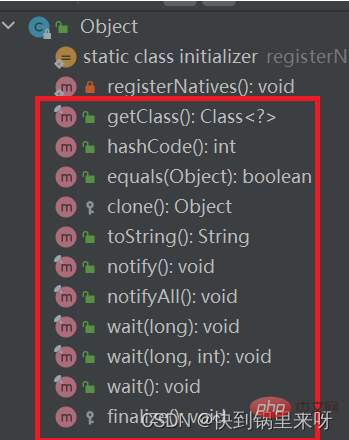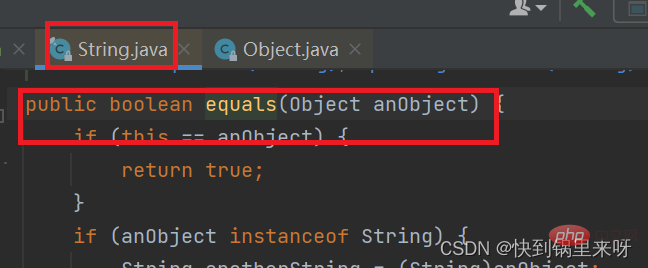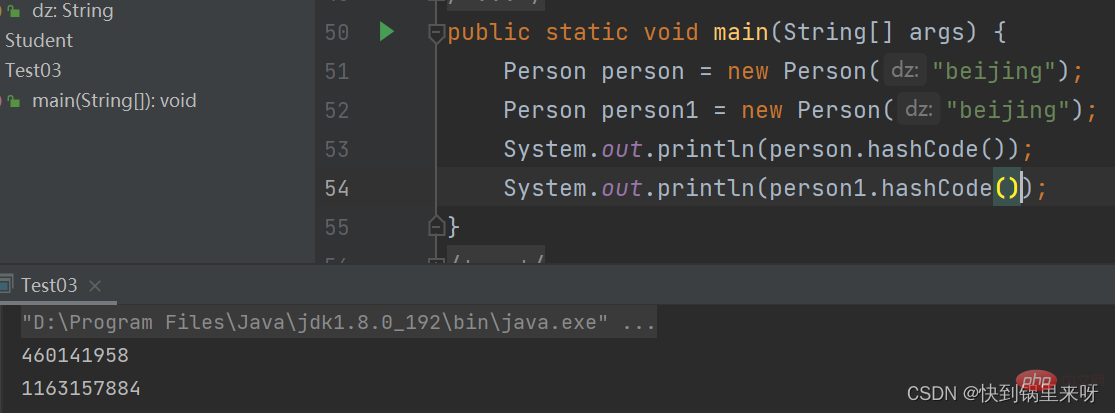Summary of Object class knowledge points in Java
This article brings you relevant knowledge about java, which mainly introduces related issues about the Object class, including what the Object class is, the equals method and hashCode method in the Object class Let’s take a look at the content below. I hope it will be helpful to everyone.

Recommended study: "java video tutorial"
1. What is the Object class?
Object is a special class in the Java class library and the parent class of all classes.
In other words, Java allows any type of object to be assigned to a variable of type Object.
Except for the Object class, all classes in Java have inheritance relationships.
The Object class is located in the java.lang package and will be automatically imported during compilation. When a class is defined, if no inherited parent class is specified, the default parent class is the Object class.
class Person {}
class Student {}
public class Test03 {
public static void func(Object o) { }
public static void main(String[] args) {
func(new Person());
func(new Student());
}
public static void main1(String[] args) {
Object o = new Person();
Object o2 = new Student();
}
}Let’s take a look at the methods in the Object class

This article will briefly introduce hashCode(), equals()
2. The equals method in the Object class
Look at this piece of code below
class Person {
public String dz;
public Person(String dz) {
this.dz = dz;
}
@Override
public String toString() {
return "Person{" +
"dz='" + dz + '\'' +
'}';
}
}
class Student {
}
public class Test03 {
public static void main(String[] args) {
Person person = new Person("beijing");
Person person1 = new Person("beijing");
System.out.println(person == person1);
}If you compare directly like this and see if the addresses are the same, false will be output, and the output is wrong
So if you want to compare, is there any way
In java A method provided is equals, which can be used to compare whether two objects are the same.
System.out.println(person.equals(person1));
If you write this directly in main, false will still be output.
This is because there is no equals, the default is inherited from Object

You can see that the comparison is still this and obj, which are the parameters currently passed in, so it is false.
So how to use equals for comparison
Then we need to rewrite an equals before we can compare
@Override
public boolean equals(Object obj) {
//判断当前obj参数是否为null
if (obj == null) {
return false;
}
if (this == obj) {
return true;
}
//不是Person类对象
if (!(obj instanceof Person)) {
return false;
}
Person ret = (Person) obj;
return this.dz.equals(ret.dz);
}We can use String to help rewrite Write equals

At this time equals can be compared

The content in the comparison object When they are the same, you need to override equals
3. The hashCode method in the Object class
Using hashCode can calculate the specific object location, which is the memory address , and then call the Integer.toHexString() method to output this address in hexadecimal
, 
The two dz are the same, and then directly use The hashCode calculates the memory address, and then the code finds that the memory address is different.
It means that it is not possible to directly enter the hashCode like this. Then you need to re-implement a hashCode,
below Rewrite hashCode,
@Override
public int hashCode() {
return Objects.hash(dz);
}and then run the code to try. Sure enough, after rewriting, the memory address is the same

## So, hashCode is To locate the position
4. The compiler automatically generates equals and hashCodeGenerally, when rewriting, these two are rewritten at the same time

@Override
public boolean equals(Object o) {
if (this == o) return true;
if (o == null || getClass() != o.getClass()) return false;
Person person = (Person) o;
return Objects.equals(dz, person.dz);
}java video tutorial"
The above is the detailed content of Summary of Object class knowledge points in Java. For more information, please follow other related articles on the PHP Chinese website!

Hot AI Tools

Undresser.AI Undress
AI-powered app for creating realistic nude photos

AI Clothes Remover
Online AI tool for removing clothes from photos.

Undress AI Tool
Undress images for free

Clothoff.io
AI clothes remover

AI Hentai Generator
Generate AI Hentai for free.

Hot Article

Hot Tools

Notepad++7.3.1
Easy-to-use and free code editor

SublimeText3 Chinese version
Chinese version, very easy to use

Zend Studio 13.0.1
Powerful PHP integrated development environment

Dreamweaver CS6
Visual web development tools

SublimeText3 Mac version
God-level code editing software (SublimeText3)

Hot Topics
 1378
1378
 52
52
 Perfect Number in Java
Aug 30, 2024 pm 04:28 PM
Perfect Number in Java
Aug 30, 2024 pm 04:28 PM
Guide to Perfect Number in Java. Here we discuss the Definition, How to check Perfect number in Java?, examples with code implementation.
 Random Number Generator in Java
Aug 30, 2024 pm 04:27 PM
Random Number Generator in Java
Aug 30, 2024 pm 04:27 PM
Guide to Random Number Generator in Java. Here we discuss Functions in Java with examples and two different Generators with ther examples.
 Weka in Java
Aug 30, 2024 pm 04:28 PM
Weka in Java
Aug 30, 2024 pm 04:28 PM
Guide to Weka in Java. Here we discuss the Introduction, how to use weka java, the type of platform, and advantages with examples.
 Smith Number in Java
Aug 30, 2024 pm 04:28 PM
Smith Number in Java
Aug 30, 2024 pm 04:28 PM
Guide to Smith Number in Java. Here we discuss the Definition, How to check smith number in Java? example with code implementation.
 Java Spring Interview Questions
Aug 30, 2024 pm 04:29 PM
Java Spring Interview Questions
Aug 30, 2024 pm 04:29 PM
In this article, we have kept the most asked Java Spring Interview Questions with their detailed answers. So that you can crack the interview.
 Break or return from Java 8 stream forEach?
Feb 07, 2025 pm 12:09 PM
Break or return from Java 8 stream forEach?
Feb 07, 2025 pm 12:09 PM
Java 8 introduces the Stream API, providing a powerful and expressive way to process data collections. However, a common question when using Stream is: How to break or return from a forEach operation? Traditional loops allow for early interruption or return, but Stream's forEach method does not directly support this method. This article will explain the reasons and explore alternative methods for implementing premature termination in Stream processing systems. Further reading: Java Stream API improvements Understand Stream forEach The forEach method is a terminal operation that performs one operation on each element in the Stream. Its design intention is
 TimeStamp to Date in Java
Aug 30, 2024 pm 04:28 PM
TimeStamp to Date in Java
Aug 30, 2024 pm 04:28 PM
Guide to TimeStamp to Date in Java. Here we also discuss the introduction and how to convert timestamp to date in java along with examples.
 Java Program to Find the Volume of Capsule
Feb 07, 2025 am 11:37 AM
Java Program to Find the Volume of Capsule
Feb 07, 2025 am 11:37 AM
Capsules are three-dimensional geometric figures, composed of a cylinder and a hemisphere at both ends. The volume of the capsule can be calculated by adding the volume of the cylinder and the volume of the hemisphere at both ends. This tutorial will discuss how to calculate the volume of a given capsule in Java using different methods. Capsule volume formula The formula for capsule volume is as follows: Capsule volume = Cylindrical volume Volume Two hemisphere volume in, r: The radius of the hemisphere. h: The height of the cylinder (excluding the hemisphere). Example 1 enter Radius = 5 units Height = 10 units Output Volume = 1570.8 cubic units explain Calculate volume using formula: Volume = π × r2 × h (4





